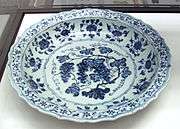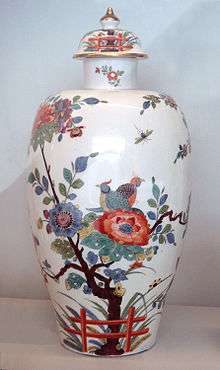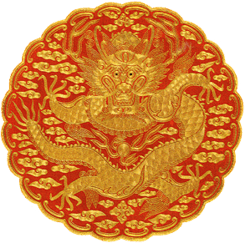Joseon white porcelain
| Joseon white porcelain | |
 | |
| Korean name | |
|---|---|
| Hangul | 조선백자 |
| Hanja | 朝鮮白磁 |
| Revised Romanization | Joseon baekja |
| McCune–Reischauer | Chosŏn paekcha |
Joseon white porcelain or Joseon baekja refers to the white porcelains produced during the Joseon dynasty (1392-1910).
History
White porcelains were preferred and praised than any other porcelains during the time to represent Korean Confucian ethics such as frugality and pragmatism.[1] In overall, Joseon ceramics undergone numerous transformations during the five hundred-year period and is generally divided into three major periods; the early, the middle, and the late period. Although the chronology of Joseon ceramics differs between scholars, three major events affected kiln production; the outcome of the Imjin wars, the establishment of Bunwon (hangul: 분원; hanja: 分院), government-subsidized kilns at Bunwon-ri, Gwangju near Seoul in 1751, and the privatization of Bunwon in 1884. Joseon white porcelains are characterized by the beauty of unpretentious forms, understated decoration, and subtle use of color, reflecting the ideals of Korean Confucian state.
Gallery
 White porcelain bowl, 15th century AD, Korea
White porcelain bowl, 15th century AD, Korea White porcelain plate, 15th century AD, Korea
White porcelain plate, 15th century AD, Korea White porcelain jar, 18th century AD, Korea
White porcelain jar, 18th century AD, Korea White porcelain ewer, 18th-19th century AD, Korea
White porcelain ewer, 18th-19th century AD, Korea
See also
- Blue and white porcelain
- Celadon
- Korean pottery and porcelain
- Chinese ceramics
- Japanese pottery and porcelain
- Japanese invasions of Korea (1592–1598)
References
- ↑ James Hoare; Susan Pares (1988). Korean, An Introduction. Routledge. p. 143 p. ISBN 0-7103-0299-1. Retrieved 2008-03-29.
- Jae-yeol Kim (2003). Handbook of Korean Art (White Porcelain and Punch'ong Ware). Laurence King Publishing. ISBN 1-85669-359-7.
- Yun, Yong-i; Regina Krahl (2005). Korean Art from the Gompertz and Other Collections in the Fitzwilliam Museum. Translated by Youngsook Pak; Roderick Whitfield. Cambridge University Press. ISBN 0-521-83592-5.
- Keith Pratt; Richard Rutt; James Hoare (1999). Korea: A Historical and Cultural Dictionary. Routledge. ISBN 0-7007-0464-7.
- Goro Akaboshi; Heiichiro Nakamaru (1975). Five Centuries of Korean Ceramics (Pottery and Porcelain of the Yi Dynasty). Weatherhill. ISBN 0-8348-1514-1.
- Claire Roberts; Michael Brand; Powerhouse Museum; Queensland Art Gallery (2000). Earth, Spirit, Fire: Korean Masterpieces of the Choson Dynasty. Queensland Art Gallery. ISBN 1-86317-080-4.
- Lee, Soyoung (October 2004). ""In Pursuit of White: Porcelain in the Chosôn Dynasty, 1392–1910 "". In Timeline of Art History. The Metropolitan Museum of Art, New York City. Retrieved 2008-03-27.
- "White porcelain (백자 白磁)" (in Korean). Empas/EncyKorea. Retrieved 2008-03-27.
- "White porcelain (백자 白磁)" (in Korean). Empas/Encyclopædia Britannica. Retrieved 2008-03-27.
External links
| Wikimedia Commons has media related to Joseon porcelain. |
- Gallery of Korean Pottery and Porcelain at Korean Overseas Culture and Information Service (KOIS)




